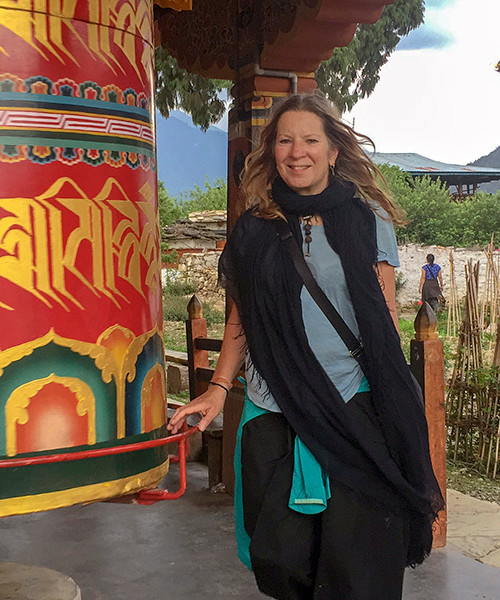M A D N E S S
If the insects, food or death aren’t responsible for dampening the enthusiasm on the retreat, what else lies lurking the shadows? Mental illness. …
While serious mental illness is unlikely to manifest on retreats, and hopefully you’ll never have to deal with it, here are three short glimpses of times when it occurred on mine. I should mention that I, too, have suffered from depression most of my life, but yoga has almost dissipated it completely, without medication. I know this is not possible for everyone. My own suffering has made me more compassionate towards others who are suffering. And, while I really believe that yoga can make a difference, its still not something I enforce or can enforce.
I’m teaching a Yoga Teacher Training program and one of my students, Aura, a 24-year old sweet girl with blond curls and blue eyes, arrives two days late. I‘m not impressed. Turns out she was travelling through Australia with her boyfriend, and they went to a music festival and did some LSD. A defective batch; others died. It’s December 2012 and Aura believes the world is about to end. On her acid trip, she transcends to a universe with extraterrestrials and finds it so blissful she doesn’t want to return to earth. Yikes! So she’s sectioned in Australia and given anti-psychotic drugs. Two days after her release, Aura shows up extremely detached and says, “All my life all I’ve ever wanted to be is a yoga teacher… but now I don’t give a damn any longer.”
“OK.” I say, “Let’s give it four days and see if you feel more grounded after doing asana practice. If you don’t feel better, then youhave to go home.” She agrees. I ask her dreadlocked boyfriend to meet me; instead, he takes Aura out of the yoga center. That evening, I go to her room to check on her and find her in a coma under her mosquito net, holding a book with instructions about how to leave the body and be with extraterrestrials. Her roommate is upset and thinks she’s dead. Understandably. I check her pulse and feel a light slight beat. I call a taxi and take her to the hospital where they run every test possible – Cat Scans, MRIs, pump her stomach, take blood samples (that surprisingly came back drug free!). Fourteen hours later, she awakes from her trance. Very impressive yogi move, I think, getting into such a deep, Samadhi-like zone – expect that it isn’t yoga. Aura is out of control and on the way back from the hospital she gets out of the car and runs wildly through the fields.
I feel the safest option for Aura is to send her home, although she insists she wants to wander around India. I point out the potential dangers and try to convince that she needs professional help. I call her parents to alert them to the urgency of the situation and ask them to come and get her. They won’t. I can see why she doesn’t want to go home, but there is no way she can do the training. In the end, Aura leaves with her boyfriend. The whole incident is very scary and affected the other students on the training, as well as being a major disruption for a couple of days. I had to wash my hands of the affair as I had other work to do.
Words of Advice:
- It’s our responsibility to keep people safe.
- Recognise when a situation is too complicated to handle. Know when you’re out of your depth. If necessary, be prepared to ask someone to leave the retreat if it will compromise their safety or is too disruptive for the group.
- Most yoga teachers do not have mental health training. We’re not doctors or psychotherapist. In the interests of mental health, get them to the professionals.
- Understand your priorities. Unless there is no one else to take care of the sick person, your priority is to be present for the other students. This is why it’s often a good idea to have an assistant who can step in for you if you have to leave.

This is what a psychotherapist suggests if someone is spinning out of control:
It’s helpful to recognise what kind of mental health crisis it is and know what could happen. If a student has a personality disorder (Borderline or Narcissistic) or latent psychosis, get help from a professional right away as it might escalate into psychosis. If someone is having a panic attack, hold her hand and ask her to look at you. Tell her to breath into the abdomen four times to bring her back into the body. It will calm her down. Find a quiet spot. Call in the professionals. When someone is ill you’ll be able to feel it instinctively. Insomnia and sleep deprivation can bring on mental illness. Watch if people aren’t sleeping, or get overexcited – manic – as they could become psychotic. Regardless of the symptoms, it’s always good to sit calmly with a person and talk to them, keep them grounded.

A year later, a similar thing happens. Karma is on medication, yet she hasn’t told me anything about her condition. Not even in the TTC application form where it asks specifically about history of mental illness and medication. It turns out that after years of working as a funeral director, Karma developed acute panic attacks. There are stories of childhood abuse. After a couple of years of meds and therapists, Karma ends up at a Deepak Chopra retreat and decides to do a Yoga Teacher Training program. She also decides to divorce her husband and sell the house. And her teenage boy is having a difficult time dealing with it all. So, Karma has a lot going on that I don’t know about.
She does really well for a bit. She doesn’t miss a class and is pleasant and friendly. One day she even binds in Marichyasana D and seems pretty pleased about that, as if it’s an affirmation that she’s getting mentally stronger. But every night, Karma is skyping her therapist, or her son, and not giving the practice a chance to take root. She’s continually pulled back into her life and her habitual patterns, a role she isn’t happy with, but neither son nor therapist support Karma’s decision to be here, or will give her the personal space necessary to undergo the yogic process.
During the practicum sessions, where I play videos of their asana demonstrations, I notice that Karma is having a difficult time, even though her work is good. Interestingly, in the yoga photography part of the course where people try to convey aspects of yoga philosophy, her images are outstanding and by far the most creative. Karma has severe self-loathing issues and hates to see herself on video so much that it brings on a minor panic attack. She breathless says, “I can bear the thought of having to watch myself on TV again. I just can’t do it.” I tell her that she doesn’t have to watch the videos and that I can give her verbal feedback instead. Karma seems OK with this, but her therapist convinces her to leave with only one week to go, enforcing a pattern where she doesn’t complete what she’s started. Karma is terrified that she will slip into madness. I see that she is projecting her thoughts wildly into the future and that her self-image is highly distorted, and that she’s unable to use the yoga skills to slow her thoughts down and analyse what’s happening. Her anxiety increases over the next few days and her breath is so short that Karma can barely breathe. I have to let her go. We tell her that it’s important that she doesn’t look at this as a ‘failure,’ and that when she’s feeling better we’ll figure out a way for her to complete the training.
Words of Advice:
- If her therapist convinces her that she’s in danger of sliding towards psychosis and needs to go home, let her go.
- Not all yoga is good for people with certain mental health issues! Certain pranayama techniques can actually be dangerous and worsen the situation. This is why it’s important for students to tell you about their history with mental illness.
- Mediation can also be dangerous and I’ve been told by Rinpoches that only after mentally ill people can deal with mundane reality, should they attempt mediation. Even the Goenka Vipassana programs don’t allow people with mental illness on to their retreats.
- Even if you believe that yoga would help her train her mind not to project thoughts wildly into the future, or dwell in the past, and that her mind would stablise and she’d get better, let her go.
- It’s safer for people with serious mental illnesses to be with professionals.
- As yoga teachers, we shouldn’t try to diagnose or treat people. We there to facilitate and give them tools to use. Not everyone is able to use them.

Yet another incident of madness occurs while i’m teaching yoga in the jungle. It’s been an epic journey to get here with an international flight to Dallas Fort Worth airport in Texas, another international flight arriving at 3 AM, sleeping at a student’s house, and then driving for 5 hours to the ferry that takes us to a island, another drive into the jungle, and finally a quad journey across two rivers to get to the yoga venue.
If her therapist convinces her that she’s in danger of sliding towards psychosis
and needs to go home, let her go.
In Dallas, my friend, Willow, has a psychotic meltdown. There is no way she can board the plane on her own. Can’t even find her passport. Damn good thing I’m here. Fortunately, Willow still knows who she is and where we’re going. She can still use an ATM machine. But after another insomniac night, probably her 7th so far, she is more disturbed in the morning. Willow stands at the edge of the loft with her chakra tuning forks in her hands and has a super intense expression on her face. Scary. On the ferry, it’s quite clear (as mud) that she only has a tenuous grasp on reality. In the car, she keeps extending her serpent like arm, fingers in a strange gesture, into the front seat. Willow is acting like she’s in some god realm and only can communicate in mudras. Her behavior is disturbing and my 21-year old assistant, Jade, is not impressed. Actually, Jade is scared and totally is out of her depth. We’re not having a good time. Welcome to the world of yoga retreats.
In retrospect, days before we got on the flight, I saw Willow’s mental illness manifesting but didn’t do anything. She kept saying, “I’m really sensitive.” And, I’d think, ‘We’re all sensitive; not just you.’ I preferred to think of her behavior more as ‘kookiness’ that she sometimes does. Instead, I wish I’d said, “You’re sick and need help. I don’t want you to come with me.” But I didn’t and why? Because I’ve always lived a marginal existence surrounded by writers, artists, yogis, healers, eccentric people and have a great tolerance for miscellaneous behavior. And, as yogis we’re encouraged to be tolerant and non-judgmental of others. But, I’ve also been taught how to be discerning, and in this part I truly failed. I wish that I’d acted on my intuition and perhaps none of this would have happened. But, it has. I also think that if Willow had stayed on her medication and seen a therapist that she would have recognized the signs herself, and prevented them from getting worse. So much involves taking responsibility for our life when we can.
We finally get to the yoga venue, and instead of finding a calm and peaceful place, the atmosphere is charged. The owner doesn’t want her here. It’s rainy season and the heavens break forth in a deluge of rain, thundering down on our aluminum-roofed condos. We’re surrounded by claustrophobic jungle and that night there is a violent thunder and lighting storm. Scary. Even for a sane person. In the middle of the night Willow creeps into my room and crawls into my bed. It’s another sleepless night for her and I’m catching up. At breakfast, the owner tells me that I must take her away. This is a problem as people have paid a lot of money, and put in a great deal of effort to get here, to study with me. There are no professionals to call in and he convinces me that I’m the only person who can deal with the situation. Miraculously, and the first time ever, I’ve invited another yoga teacher to join me. Thank god she’s here! She’s a serious yogini who gracefully leads the retreat while I ‘m gone for four days to take care of my friend.
Needless to say, the 8-hour return journey is not easy. But, interestingly, I feel clear and calm. I’m confident that no matter what happens I’ll be able to deal with it. I feel fearless. Every time Willow gets out of the car it takes me 20 minutes to convince that it’s safe to get back in. She is delusional and paranoid, afraid that people are in the vehicle and will hurt her. This time she can’t approach the ATM, as it’s become the Lord of Death with gaping jaws. No money. Driving by the children’s hospital Willow suddenly gasps with horror as if absorbing the suffering of all of the children. She says, “We’re eating our children.” By now, I’m beginning to feel that I really am out of my depth but I have to keep it together. I find the perfect hotel where the owners are extremely kind and understanding, even when Willow wanders the hotel like a ghost.
Willow has barely eaten in days and it takes me two hours to feed her a meal. When we get home she is crawling on the bedroom floor. Her face has become distorted and her breath is vile. I’ve read that some psychoses make people violent. Despite this, I’m not really scared of her, as I don’t think Willow is capable of violence. But, she no longer knows who she is, or where she is, and her speech is distorted, at times she refers to herself in the second person. She even forgets who I am. I feel incredible love for her and a desire to take care of her, but I’m also being stern and Willow listens to me.
Why? Because I’ve always lived a marginal existence and have great tolerance for miscellaneous behaviour.
The next day we visit a psychiatrist and a psychotherapist. (I’m doing all this in a foreign country where I don’t speak the language.) There is much discussion about what to do and there aren’t many options. I’d hoped to just get a sedative and put her on a plane with her brother, but they won’t let her fly in this condition. Even if we could do this, they strongly discourage me from the med/plane scenario, saying that if Willow has an adverse reaction to the drugs in the hotel room that I might not be able to handle the situation. Quite right! I’m not sleeping much as it is, sharing a room with a crazy person who now sits on the edge of my bed and stares at me. I realise how frightened Willow is as she crawls into bed with me, and that she really needs me to be there. I’m struggling between her needs and my own, yet it seems impossible to maintain boundaries. Sleep is essential for clarity of mind and I know that in order to truly take care of others, we need to take care of ourselves first. I’m slipping into a fragile place. I’m totally exhausted and very upset.

Deciding to section Willow in a foreign country, at the State Psychiatric Hospital, is one of the most difficult things I’ve ever had to do. But the severity of the situation leaves me no choice. She is hearing voices, having paranoid hallucinations, doesn’t know who she is half of time, and she takes on the suffering of all beings around her with such conviction that it’s truly painful to watch. We sit in emergency for hours, before I tell them I can’t guarantee she will not bolt. Finally, we’re inside but, again, the waiting is interminable. Other mentally ill people come and go. It’s impossible to get any of Willow’s medical records, or medication history, thanks to privacy laws in the UK. Not even her brother can get information. So, the doctors have little information to go on.
Willow is now lying on the floor and I tell her to sit in a chair so they don’t think she’s crazier than she is. This seems to work. The nurses bring some green pajamas and slippers, and as I dress Willow in the bathroom, she asks what they’re going to do her. She’s terrified and I don’t blame her. Heart-wrenching. They put Willow in a wheel chair and take her away, inside, strap her to a bed and give her anti-psychotic medicine. I make them promise that under no circumstances will they give her shock therapy. No visitors are permitted. I feel like I’m abandoning Willow and that’s not a good for someone like me who’s adopted. It brings up emotions, whips up my mind dragging up the past, unleashing samskaras. I wait around another day for her brother to arrive and prepare him for the worst.
Deciding to section Willow in a foreign country is one of the most difficult things I’ve ever had to make.
I head back into the jungle, into a kind of heart of darkness, Kurtz-style. I’m more exhausted and disturbed by the experience than I let on. My foundations of reality are shaken. I return to London as a shell of myself, totally exhausted, without the ability to concentrate, and feel a disturbing groundlessness as I look at my own issues of dishonesty and deception. I’m depressed, stuck in a deep Samsaric existential hole. One thing that keeps resonating with me is a comment made by Dzongsar Jamyang Khentsye Rinpoche: “Don’t disturb others; and don’t deceive yourself.” This becomes my mantra and reality check for my own actions. Ahimsa. Satya.

As disturbing as it is to sit with all that has come up, surprising I discover that my fear level has decreased. I feel purified by the experience. But, I’m still deeply shocked by how tenuous the grasp of the mind on reality can be. I wonder if Willow is the same person, whether sane or sick, on or off medication? What part of her is really she? What is the nature of mind? What is the essence of Self? The Willow that I know seems to have disappeared. She doesn’t thank me because she can’t remember what happened. I know that my actions saved her life.
Ultimately, this experience has been a blessing. One that took me to a deep place of intense suffering, tolerance, patience, and compassion that I might otherwise not have experienced. And I realise that my yogic path is working, as it gave me the ability to be totally present and deal with reality however it manifests, and act with compassion, kindness, and non-judgment. For this I’m truly grateful! A decade ago, I would not have been able to do this.
Words of Advice:
- The deeper you are in the jungle, the more difficult it is to get help.
- No matter what, it’s our responsibility to keep people safe. If you’re out of your depth, get them to a professional as fast as you can.
- Some pranayama and mediation techniques are not recommended for mentally ill people. A Rinpoche once told me that only after someone can deal with mundane worldly activities, does he begin to teach them meditation.
How to prepare yourself to help someone with mental health issues:
- Study yoga seriously and develop a meditation practice, so that your own mind will be stable and calm and better suited to deal with complicated situations.
- Short of actually getting a diploma in Cognitive Behavioural Psychology, or a degree as a psychotherapist, the best thing you can do is research. Read articles about the mental illness, neuroscience, and different forms of therapy. Talk to psychotherapists and yoga teachers who regularly deal with mentally ill people. Talk to mentally ill people.
- Get over your fear of mental illness. We are all afflicted to some degree. It’s the nature of saṃsāra (the suffering of the human condition.)
Continued in Part 3 >
3 Comments
Leave A Comment
You must be logged in to post a comment.






What happened to willow? Did she end up okay?
Willow is OK. We’re good friends again. Thanks for asking.
I’m sorry if this posts again—not sure if it went before. I was wondering if Willow ended up safe, or got help? You really tried your best in a tough situation.